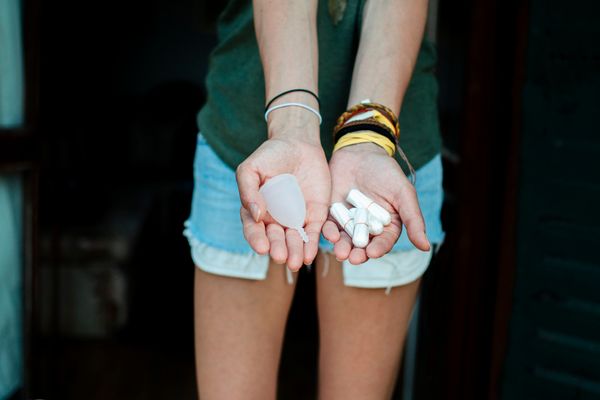Long before Natalie Hayden, 38, was diagnosed with Crohn’s disease in 2005, she struggled with another health problem: anemia. “Fatigue and weak spells were my biggest issues. I fainted in fourth grade on the teacher's desk,” she said. To this day, she wonders if her anemia was a sign of what was to come with Crohn’s.
About 17% of premenopausal women in the United States are affected by iron deficiency anemia (IDA), meaning their bodies lack the iron needed to produce healthy red blood cells that carry oxygen to organs and tissues.
Women are at higher risk of IDA because they lose blood every month during their periods, and many cases are caused by heavy periods (also known as heavy uterine bleeding). But lots of conditions and diseases are connected to IDA, and understanding these connections may help women know whether they’re at risk.
Signs you may have IDA
IDA isn’t always obvious, especially since its symptoms may overlap with those of other health conditions. In Hayden’s case, it was hard to tell where IDA ended and Crohn’s began. “Oftentimes it's difficult to [tell the difference] between Crohn's symptoms and anemia because both can make you feel extremely fatigued,” she said.
Since women with conditions such as Crohn’s are already dealing with a variety of symptoms, it’s important to know what to watch for when it comes to IDA. Signs include:
- Weakness
- Extreme tiredness
- Cold hands and feet
- Pale skin
- Fast heartbeat
- Headache
- Dizziness or lightheadedness
- Brittle nails
“We see a lot of women who are chronically anemic and might not even know it,” said Dr. Heather Bartos, an OB-GYN, sexual health expert and member of HealthyWomen's Women's Health Advisory Council. She added that these women often have vague symptoms in addition to fatigue, such as low sex drive, depression, anxiety and shortness of breath.
If you’re experiencing any of these symptoms, talk to your healthcare provider (HCP) — even if they’re caused by something other than IDA, they’re worth mentioning.
Inflammatory bowel disease and IDA
Inflammatory bowel disease (IBD) is an umbrella term that covers Crohn’s disease and ulcerative colitis, both of which involve inflammation of the digestive tract. Crohn’s and ulcerative colitis share common symptoms like diarrhea and rectal bleeding, as well as the potential to cause IDA.
People with IBD may have IDA because chronic inflammation of the intestines can lower your body’s ability to absorb iron and other nutrients. Blood loss from intestinal bleeding can also be a factor.
“With Crohn's, if you are in an active flare, there can be consistent internal bleeding going on that isn't necessarily visible in your stool but can still make you anemic,” Hayden said.
Hayden has been taking a prescription multivitamin with iron since 2015, when she had bowel resection surgery that put her Crohn’s in remission. While her iron levels have been stable since then, her gastroenterologist (GI doctor) still checks them every three months to be sure.
People with IBD who aren’t in remission like Hayden may not be able to tolerate iron supplements because they may be too hard on the digestive system if their IBD is flaring up. Be sure to check with your HCP before taking iron and ask about treatments that can be taken if you have trouble with iron supplements.
Cancer and IDA
For people with cancer, IDA can be caused by the cancer itself. Some types of cancer (like lymphomas and breast cancer) can invade bone marrow, replacing red blood cells with cancer cells. Others cause the body to overproduce cytokines, proteins that can slow down the creation of red blood cells. Lack of red blood cells leads to IDA.
Colleen Hayes, 48, was told by her doctor to take iron supplements before starting chemo for breast cancer in 2017. “It seemed as though it was assumed anemia would happen with the chemotherapy I was taking,” she said.
Cancer and chemotherapy can also affect the way a person eats. Loss of appetite or mouth sores caused by chemo sometimes make it hard for people with cancer to get the nutrients they need, which can lead to IDA.
Kidney disease and IDA
Anemia is common in people with kidney disease. When the kidneys are damaged, they produce less of a hormone called erythropoietin (EPO) that helps produce red blood cells. Having fewer red blood cells means less oxygen gets to your organs and tissues, resulting in IDA.
Other causes of anemia related to kidney disease include:
- Malnutrition, meaning the body isn’t getting enough nutrients
- Blood loss, especially for people with kidney failure being treated with dialysis
- Infection
IDA becomes more likely as kidney disease gets worse, so it’s a good idea to have your iron levels checked regularly if you have kidney problems.
When in doubt, get checked for IDA (and eat your greens)
With new research suggesting IDA may be even more common than we realize, it’s important for women who may be at risk to talk to an HCP about getting their iron levels checked. A simple blood test can tell you whether you have IDA. “Always ask your doctor to check your iron stores, as well as your blood count, to look for ‘hidden’ anemia,” Bartos said.
Supplements and treatment aside, Bartos said adding certain foods to your diet is a great way to boost your iron intake. “Think dark leafy greens (not the old beef trick we’ve always been told), beans, lentils and even potatoes,” she said. She added that iron is better absorbed by the body when paired with vitamin C, so toss some strawberries into your spinach salad for a healthy dose.
This resource was created with support from Daiichi Sankyo, Inc.
- My Heavy Menstrual Bleeding Led to Iron-Deficiency Anemia and ... ›
- Boost Your IDA IQ: An Overview of Iron Deficiency Anemia ... ›
- Heavy Uterine Bleeding and Iron Deficiency Anemia Can Affect ... ›
- Iron Deficiency Anemia and Heavy Periods: What's the Connection ... ›
- Iron Deficiency Anemia Can Cause Serious Problems for Pregnant ... ›
- Fast Facts About Iron Deficiency - HealthyWomen ›
- Iron Deficiency Anemia: Get the Facts - HealthyWomen ›







